2011: 3000 Elephants slaughtered for asians
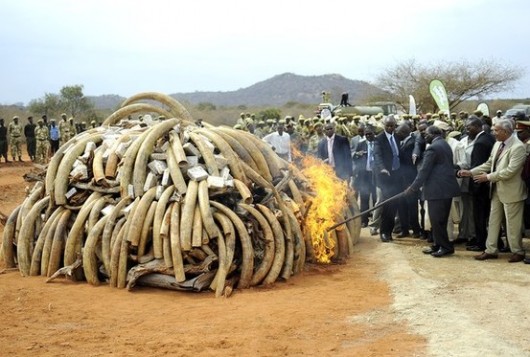 It’s 2011 and east asians are ramping up the extermination of elephants for backward TCM medicine
(TCM is Traditional Chinese Medicine)
.
Kenya’s President Mwai Kibaki sets on fire an illegal ivory stockpile on July 20, 2011 at the Tsavo National Park, approximately 350 kilometres southeast from Nairobi. Kenya’s President Mwai Kibaki ignited nearly five tonnes of ivory stockpiled in the country since being seized in Singapore nearly a decade ago destroying some 335 tusks and 42,553 pieces of ivory carvings at the Manyani wildlife rangers training institution in eastern Kenya.
(©Photo: Tony Karumba/AFP/Getty Images)
It’s 2011 and east asians are ramping up the extermination of elephants for backward TCM medicine
(TCM is Traditional Chinese Medicine)
.
Kenya’s President Mwai Kibaki sets on fire an illegal ivory stockpile on July 20, 2011 at the Tsavo National Park, approximately 350 kilometres southeast from Nairobi. Kenya’s President Mwai Kibaki ignited nearly five tonnes of ivory stockpiled in the country since being seized in Singapore nearly a decade ago destroying some 335 tusks and 42,553 pieces of ivory carvings at the Manyani wildlife rangers training institution in eastern Kenya.
(©Photo: Tony Karumba/AFP/Getty Images)
2011 has truly been a horrible year for elephants
~Tom Milliken, Elephant and Rhinoceros expert for the wildlife trade monitoring network ‘TRAFFIC’.
Large seizures of elephant tusks make this year the worst on record since ivory sales were banned in 1989, with estimates suggesting as many as 3000 elephants were killed by poachers as Asian syndicates move into the continent.
Tom Milliken, elephant and rhino expert for the wildlife trade monitoring network Traffic, said: “2011 has truly been a horrible year for elephants.”
In one case earlier this month, Malaysian authorities seized hundreds of African elephant tusks worth $1.3 million that were being shipped to Cambodia. The ivory was concealed in containers of Kenyan handicrafts.
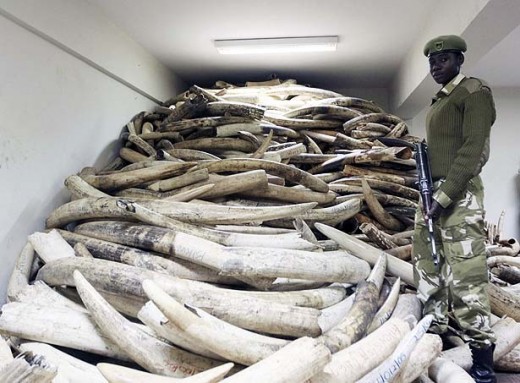 ‘Around 23,000 elephants live in Kenya but populations can be devastated by poaching within a couple of years.
A recent survey in Chad showed its elephant population had declined from 3,800 to just over 600 in the past three years.’
^http://www.thestar.com/article/692972
‘Around 23,000 elephants live in Kenya but populations can be devastated by poaching within a couple of years.
A recent survey in Chad showed its elephant population had declined from 3,800 to just over 600 in the past three years.’
^http://www.thestar.com/article/692972
.
“In 23 years of compiling ivory seizure data . . . this is the worst year ever for large ivory seizures,” said Milliken.
Most cases involve ivory being smuggled from Africa into Asia, where growing wealth has fed the desire for ivory ornaments and for rhino horn that is used in traditional medicine, though scientists have proved it has no medicinal value. Traffic said Asian crime syndicates were increasingly involved in poaching and the illegal ivory trade across Africa, a trend that coincides with growing Asian investment on the continent.
“The escalation in ivory trade and elephant and rhino killing is being driven by the Asian syndicates that are now firmly enmeshed within African societies,” Milliken said. “There are more Asians than ever in the history of the continent, and this is one of the repercussions.”
Reports from Central Africa were particularly alarming and if current levels of poaching were sustained, some countries, such as Chad, could potentially lose their elephant populations in the very near future, said Jason Bell, director of the International Fund for Elephant Welfare.
In Tanzania’s Selous Game Reserve alone, some 50 elephants a month are being killed, according to the Washington-based Environmental Investigation Agency. It has been a disastrous year for elephants, perhaps the worst since ivory sales were banned in 1989 to save the world’s largest land animals from extinction.
According to the wildlife trade monitoring network TRAFFIC, a record number of seizures of elephant tusks from at least 2,500 dead animals shows that organised crime networks, in particular Asian syndicates, are increasingly involved in the illegal ivory trade and the poaching that feeds it.
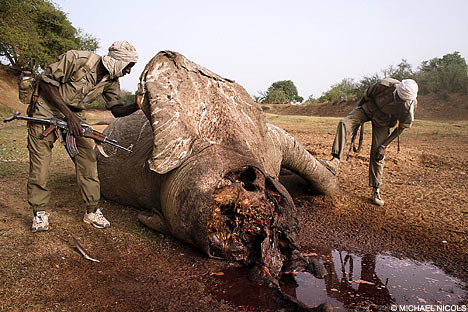 Endangered elephant butchered for TCM
(Photo by Michael Nichols)
Endangered elephant butchered for TCM
(Photo by Michael Nichols)
.
Some of the seized tusks came from old stockpiles, the elephants having been killed years ago. It is not clear how many elephants were recently killed in Africa for their tusks, but experts are alarmed.
TRAFFIC’s elephant and rhino expert Tom Milliken thinks criminals may have the upper hand in the war to save rare and endangered animals: “The escalation in ivory trade and elephant and rhino killing is being driven by the Asian syndicates that are now firmly enmeshed within African societies.”
Miliken said: “There are more Asians than ever before in the history of the continent, and this is one of the repercussions.”
Most cases involve ivory being smuggled from Africa into Asia, where growing wealth has fed the desire for ivory ornaments and for rhino horn that is used in traditional medicine, though scientists have proved it has no medicinal value.
All statistics are not yet in, and no one can say how much ivory is getting through undetected, but “what is clear is the dramatic increase in the number of large-scale seizures, over 800kg in weight, that have taken place in 2011,” TRAFFIC said in a statement.
.
Asian Elephant Parts Trade:
.
In the most recent case, Malaysian authorities seized hundreds of African elephant tusks on December 21 worth $1.3m that were being shipped to Cambodia, hidden in containers of handicrafts from Kenya. Most large seizures have originated from Kenyan or Tanzanian ports, TRAFFIC said.
Fifty elephants a month are being killed, their tusks hacked off, in Tanzania’s Selous Game Reserve, according to the Washington-based Environmental Investigation Agency.
With shipments so large, criminals have taken to shipping them by sea instead of by air, and falsifying documents with the help of corrupt officials, monitors said.
Milliken said some of the seized ivory has been identified as coming from government-owned stockpiles, made up of confiscated tusks and those of dead elephants, in another sign of corruption.
“In 23 years of compiling ivory seizure data … this is the worst year ever for large ivory seizures,” said Milliken.
Africa’s elephant population was estimated at between 5 million and 10 million before the European colonisation era. Massive poaching for the ivory trade in the 1980s halved the remaining number of African elephants to about 600,000.
.
Tusk seizures double in last year as syndicates continue to undermine 1989 ban on sale of ivory.
.
It’s a big business year for illegal African ivory. A record number of ivory seizures were made globally this year, produced by an enormous surge in elephant poaching.
Central Africa is most brutally affected, with most of the illegal African ivory collected for China or Thailand where most of the tusks are made into jewelry and art carvings. Tom Milliken in Zimbabwe manages Traffic, which operates an Elephant Trade Information System. He says
“A conservative estimate of the weight of ivory seized in the 13 largest seizures in 2011 puts the figure at more than 23 tonnes, a figure that probably represents some 2,500 elephants, possibly more.”
The Guardian reports that Millliken also says that the 13 large-scale seizures of over 800kg of ivory recorded in 2011, compares with just six seized in 2010. He notes that’s the largest amount of seizures in the more than two decades since he’s been operating his database.
The increased poaching and illegal trade are the result of China’s decision to make an investment drive into Africa to obtain the mineral and energy resources it needs to fuel its economic growth.
Milliken comments:
“We’ve reached a point in Africa’s history where there are more Asian nationals on the continent than ever before. They have contacts with the end-use market and now they are at the source in Africa. This is all adding up to an unprecedented assault on elephants and other wildlife”
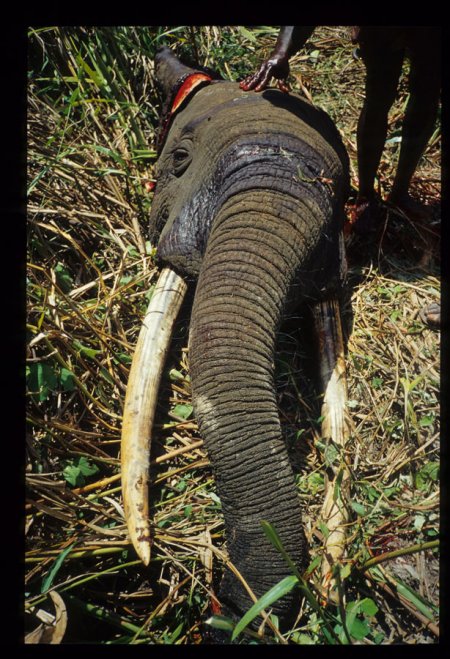 Such a heinous crime invokes capital punishment – eye for and eye beheading
Such a heinous crime invokes capital punishment – eye for and eye beheading.
He concedes it is possible that some of the ivory getting into illegal markets could be coming from African government stockpiles from old seizures. But Milliken points out that trade figures and wildlife monitors show a rise in elephant killings. Most of the kilings he notes are occurring in the Congo, but poaching is also going on in Zimbabwe, Zambia, northern Mozambique, Tanzania and Kenya.
In 1989, a global ban placed on the ivory trade was credited with stemming the unstoppable slaughter of African elephants in Africa’s central region. Since then, African governments have sanctioned occasional auctions from its stockpiles.
It’s believed Africa’s elephant population varies widely from 400,000 to 700,000. Some southern African states like Botswana have large and growing populations and in South Africa burgeoning elephant populations are raising concerns that they are damaging the environment.
[Sources: ‘Asian gangs fuelling spike in tusk trade’, The Associated Press, 20111231, ^http://www.theaustralian.com.au/news/world/asian-gangs-fuelling-spike-in-tusk-trade/story-e6frg6so-1226233555088, ‘Thousands of Africa’s elephants killed for record ivory stash’ by Joan Firstenberg, 20111229, ^http://www.digitaljournal.com/article/316904, ‘Worst year in decades for endangered elephant‘, 20111229, ^http://www.aljazeera.com/news/africa/2011/12/2011122918518597763.html]
About TRAFFIC
TRAFFIC, the wildlife trade monitoring network, works to ensure that trade in wild plants and animals is not a threat to the conservation of nature.
Check website: ^http://www.traffic.org/
.
.
‘There is a war taking place on our planet for which there are no headlines, no demonstrations, and no voice. It is a war against some of the most endangered species on our planet and it takes place in some of the most majestic and unexplored biospheres of the world. Unseen and untouched by the Western world, these places are well-suited to commit atrocious acts in hiding.’
~ Bush Warriors (‘A global voice for wildlife’)
^http://bushwarriors.wordpress.com/about-bush-warriors/
.
.
Traditional Chinese Medicine – a backward asian cult that must be eradicated!
.
TCM is 5000 years old. Its quacks profit from promising cures for headaches, skin disorders, irritable bowel syndrome, constipation and diarrhoea, stress, allergies, and impotence. Of Traditional Chinese Medicine (TCM) that relies on slaughtering endangered wildlife for their body parts for potions, it promotes a sick barbaric trade. It is a witchdoctor cult.
In the West, when something happens we ask what we can do about it. In the East when something happens they ask what has caused it. Traditional Chinese Medicine looks for the underlying causes of imbalances and patterns of disharmony within the body, blabs on about Yin and Yang, then goes out and slaughters endangered wildlife for their body parts to make a dodgy quack potion.
Boycott Traditional Chinese Medicine. It is illegal by driving the illegal trade in endangered species. It is more barbaric than the child sex trade.
.
Boycott Sydney Acupuncture
^http://www.sydneytcm.com/herbal_medicine.html
.
Boycott Australian Natural Medicine Centre
^http://www.traditionalchinesemedicine.com.au/services-chinese-herbal-medicine-sydney.php
.
Boycott all Traditional Chinese Medicine quacks.
Australian model Elle Macpherson does. Since 2010 she says she regrets any distress she may caused by jokingly advocating the use of powdered rhino horn, a traditional Chinese medicine that is banned worldwide, during an interview with The Sunday Times Magazine, the Australian model said that she had tasted rhino horn and that it had “done the job“. The model told news.com.au today that she had “never knowingly consumed or encouraged the use or consumption of any products which contain material derived from endangered species”.
.
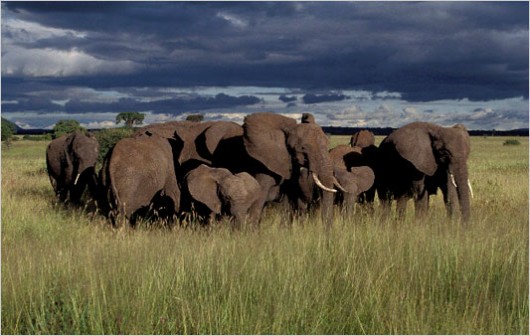 Elephants in defensive huddle
©Photo by Charles Foley
Elephants in defensive huddle
©Photo by Charles Foley
.
Tags: Asian Elephant Parts Trade, Bush Warriors, Cambodia, China's investment in Africa, elephant poaching, ivory ornaments, Ivory trafficking, Kenya, Malaysia, Mozambique, Tanzania, Tanzania's Selous Game Reserve, TCM, TCM witchdoctor cult, Traditional Chinese Medicine, TRAFFIC, wildlife poaching, Zambia, Zimbabwe

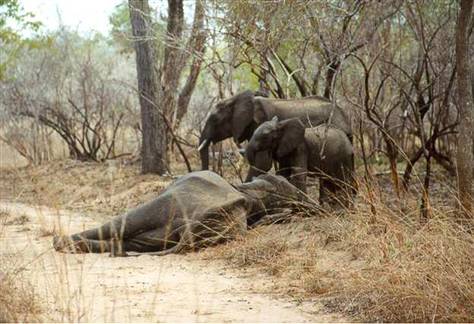







This article smacks of anger and bigotry. Anger, I can understand, for I feel the same anger and actual rage for the heinous crimes committed against defenseless and innocent animals, these magnificent and beautiful creatures of nature. The bigotry, however, is totally unnecessary.
How do I know this? I am Asian.
And I am very much against dog meat eating, (even horses, which is common fare in parts of Europe, such as Italy). I cannot see the logic and abhor the killing of innocent creatures for their pelts, their gall bladders, tusks, horns, brains, meat and what have you, for their purported ‘properties’.
This article uses the word ‘Asian’ as though every Asian grew up in the same family with the same father. We do not. Asian… ‘Asian’ refers to the single most populous group of people in the world today. And as Germans are different from Russians as Danish are different from French, every ‘Asian’ is different.
Unless you would deem New Zealanders no different from Americans when you mention ‘white people’, or a Nigerian no different from a Paupa New Guinean when you mention ‘black people’, please do exercise forethought before tarring everyone with the same brush when you use the word ‘Asian’. We are all different and as an Asian, I do support and advocate what is written in this article. Thank you.
Facebook Bernie,
Thank you for your feedback.
The article is intended to be angry, but it is critical of the reported causes of the elephant poaching; the main one is to profit from the demand from Traditional Chinese Medicine (TCM). TCM is a practice by chinese, malaysians, thais, cambodians and other east asian peoples. Grouping these as ‘asians’ is factually correct and not intended to be biased against all asians. If you are aware of any member of these groups publicly critical of TCM, then we shall be happy to support them in an article on our website.
The available space for an article title is limited, so we have to be concise. Can you suggest an alternative title of the same length? Would you prefer it if we used ‘TCM’ in the title instead of ‘asians’?
We shall be publishing articles challenging and critical of any people or individuals reported to have poached wildlife. In fact New Zealanders killing feral possums to perpetuate a backward trade in fur is coming up on our list.
We do not wish to cause offence to anyone of any ethnic group. It is the behaviour we are challenging, not ethnicity. We are not biased against any people or culture per se. But if anyone poaches wildlife or is cruel against wildlife or animals, we have a right to criticise their immoral behaviour, irrespective of their claimed justification.
If you click on the right side section under ‘Habitat Threats – all articles’ and specifically ‘Threats from Poaching and Poisoning’, you will realise that we do not exclude any poacher of any ethnic background from criticism. Just like poachers think they have open season on wildlife, our articles represent an open season on all poachers.
~ Ed.
I understand both points but i must agree with Bernie when she suggests we need to be careful about blaming a race for such a huge problem. If you do not ‘have room’ to explain everything then don’t write the article. The people who buy ivory/rhino horn/tiger bones are so far distanced from the horrible deaths these animals face that they don’t care about them. Its about money and status. ‘Asians’ don’t hate animals. Nor do the people who kill them. Sometimes its also about culture and tradition and being stuck in old habbits. Humans are always so quick to find someone to blame when faced with problems. It is particularly easy to blame a whole race. Nice and vague. Its not an easy problem to solve and I’m certainly not saying i have all the answers. I just know that the blame game just lets to hate – and hating Asians won’t save elephants. Basically all these comments could be avoided if the article was more specific and professional regarding which countries are buying ivory the most. Also, i recently red an article on legal Rhino hunting – something which hunters from all over the world are participating in. Being a New Zealander I can also say that the reason possums are ‘poached’ are because they are decimating our forests and are classified as pests. Its unfortunate that they were introduced in NZ as i have nothing against them and they are popular in other countries. Possums in NZ and ‘poached’ the same way Australians ‘poach’ rabbits or cane toads. Its a crappy situation and it surpasses race. Thanks